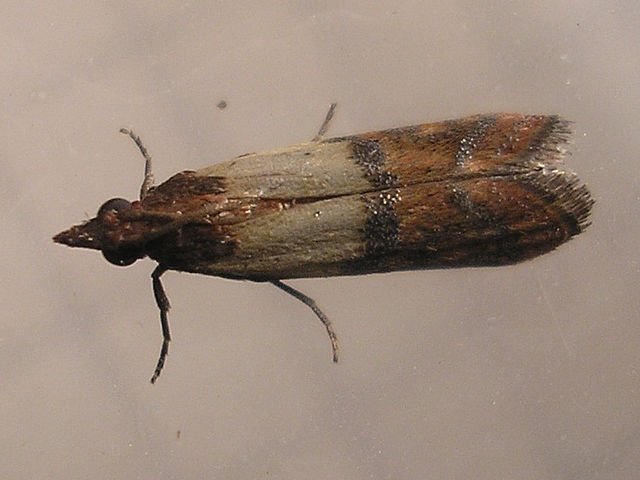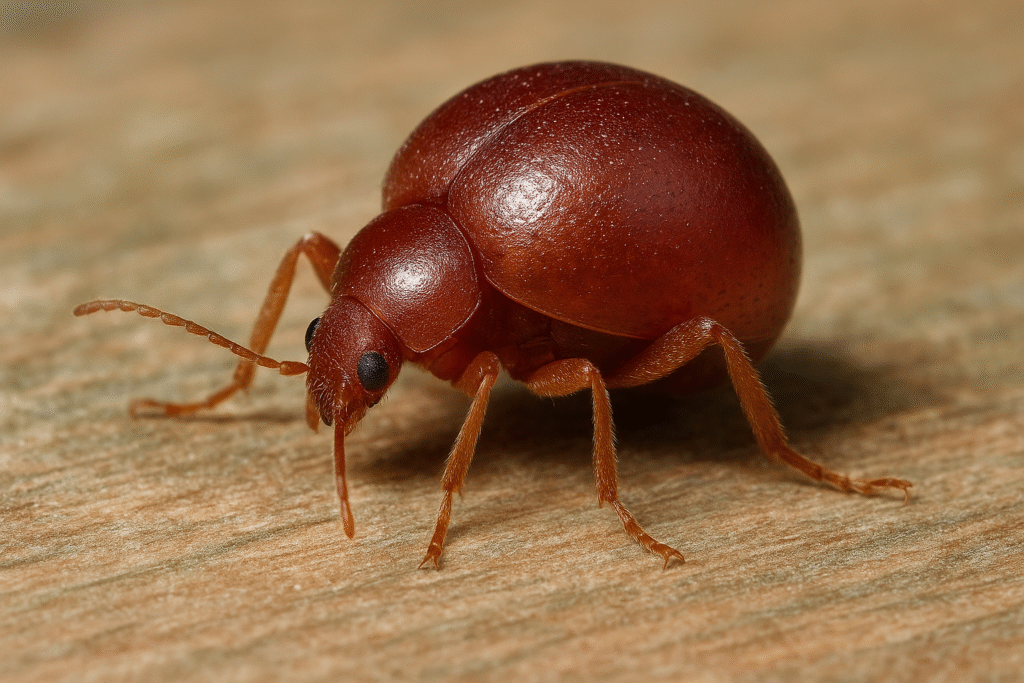Larder Beetles (Dermestes lardarius): Identification, Risks, and Control
 Larder beetles (Dermestes lardarius) are one of the most common and destructive stored-product pests found in homes, restaurants, food warehouses, and even museums. Their name comes from the word “larder,” an old term for a food storage room. True to their name, these beetles feed on stored foods, cured meats, animal hides, and even taxidermy specimens.
Larder beetles (Dermestes lardarius) are one of the most common and destructive stored-product pests found in homes, restaurants, food warehouses, and even museums. Their name comes from the word “larder,” an old term for a food storage room. True to their name, these beetles feed on stored foods, cured meats, animal hides, and even taxidermy specimens.
They are part of the Dermestid beetle family, a group well known for feeding on animal proteins and fats. Unlike pantry moths or ants, larder beetles are more specialized—they thrive on products with high protein or fat content. This makes them a serious pest wherever animal products are kept.
In this article, we’ll look at how to identify larder beetles, understand their biology, the risks they cause, and the most effective control methods for homes and businesses.
Ιdentification
Adult larder beetles are easy to recognize if you know what to look for:
Size: 7–9 mm long (about 1/4–3/8 inch).
Color: dark brown to black, with a distinctive yellowish band across the upper wings (elytra) marked by six dark spots.
Shape: oval, slightly flattened body.
Larvae: worm-like, dark brown, covered in stiff bristles (hairs), with two curved spines at the tail end.
Behavior: adults are often found near food or crawling toward windows in spring. Larvae tend to bore into wood, insulation, or packaging when ready to pupate.
Because of their striking yellow band, adults are easier to identify than many other pantry pests.
Biology and Lifecycle
The life cycle of the larder beetle is important for understanding infestations.
Eggs: females lay 100–150 eggs in cracks near food sources. Eggs hatch in about 12 days.
Larvae: the damaging stage. They feed on food, hides, feathers, or other animal products for 40–50 days.
Pupation: mature larvae often bore into wood, cork, or insulation to pupate, leaving holes behind.
Adults: live 2–3 months, during which they feed and reproduce.
The entire life cycle takes 40–50 days under warm conditions, allowing several generations per year.
Where They Are Found
Larder beetles are usually associated with:
Stored food products: cured meats, cheeses, dried fish, pet food, dried insects, or jerky.
Animal hides and furs: including taxidermy mounts, leather, and wool.
Bird and rodent carcasses: infestations often begin when beetles find dead rodents in walls or attics.
Beehives: sometimes attack beehives, feeding on brood combs or dead bees.
Pantries and warehouses: infest packaged foods if left unchecked.
Because larvae bore into materials to pupate, infestations may leave structural damage in furniture, wooden beams, or insulation.
Risks and Damage
Larder beetles are not dangerous to humans in terms of disease transmission, but their impact is serious:
Food contamination: infest stored foods, making them unfit for consumption.
Damage to materials: larvae bore into wood, cork, insulation, and packaging.
Economic losses: infest warehouses, food production sites, and taxidermy collections.
Beehive destruction: infest weak hives, feeding on dead bees and comb.
Nuisance: seeing beetles crawling in kitchens, cupboards, or windows can be alarming.
Signs of Infestation
You may have a larder beetle infestation if you notice:
Adult beetles with yellow wing bands crawling indoors.
Shed larval skins near food or cracks.
Small holes in wood, insulation, or packaging (from pupating larvae).
Infested dried pet food, meat, cheese, or wool.
Dead rodents or birds nearby—beetles often start in animal remains.
Control Methods
Sanitation
Inspect all food items, especially pet food, dried meats, and cheeses.
Discard infested products immediately.
Vacuum cupboards, pantries, and cracks thoroughly.
Clean up rodent or bird carcasses in attics, chimneys, or walls.
Prevention
Store dry goods and pet food in airtight containers.
Keep pantries cool and dry.
Inspect taxidermy, hides, and wool for signs of infestation.
Regularly check attics and basements for animal nests or carcasses.
DIY Control
Freezing: Place small infested items in the freezer (–18 °C / 0 °F for 3–7 days).
Heat treatment: Heat above 55 °C (131 °F) for 1 hour can kill beetles and larvae.
Sticky traps: Monitor beetle activity.
Insecticidal dusts: Apply diatomaceous earth or silica gel in cracks.
Professional Pest Control
For serious infestations, especially in warehouses or food production areas, professional treatment is needed. This may include:
Residual insecticides in cracks and crevices.
Insect growth regulators (IGRs) to disrupt reproduction.
Fumigation in large facilities.
FAQ
Q: Why are larder beetles in my house?
A: They are attracted to stored foods, pet food, or even dead rodents in walls.
Q: Do larder beetles bite humans?
A: No, they do not bite or sting.
Q: Are larder beetles dangerous?
A: Not directly, but they contaminate food and damage materials.
Q: How do I get rid of larder beetles naturally?
A: Discard infested food, freeze small items, and vacuum thoroughly.
Q: Do larder beetle larvae eat wood?
A: They don’t eat wood but bore into it to pupate, causing holes.
Final Thoughts
Larder beetles are a persistent pest in homes and businesses where animal-based products are stored. They are not harmful to human health, but the damage they cause to food, hides, and structures can be extensive. Early identification and proper sanitation are key. If infestations spread or involve commercial facilities, professional pest control is the most reliable solution.
Read more in our blog and explore guides on many other enemies. Stay informed.
Learn more about other Stored Product Pests
Disclaimer
This article is for informational purposes only. Pest control laws and approved chemicals vary by country. For best results and legal safety, we strongly recommend contacting a licensed pest control professional in your local area. Always make sure that the pest control technician is properly certified or licensed, depending on your country’s regulations. It’s important to confirm that they only use approved products and apply them exactly as instructed on the product label. In most places in Europe, UK, or USA, following label directions is not just best practice—it’s the law.
Author
Nasos Iliopoulos
MSc Agronomist & Certified Pest Control Expert
Scientific Director, Advance Services (Athens, Greece)
Licensed Pest Control Business – Ministry of Rural Development & Food (GR)
References
University of Minnesota Extension – Larder Beetles
Wikipedia – Dermestid Beetles


